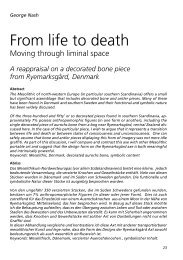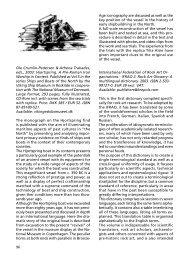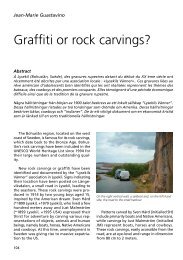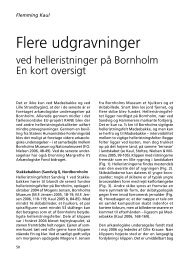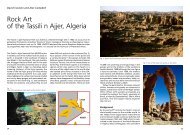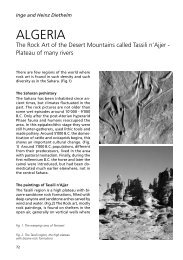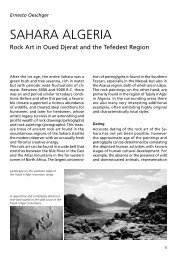Udgravninger ved helleristninger
Udgravninger ved helleristninger
Udgravninger ved helleristninger
Create successful ePaper yourself
Turn your PDF publications into a flip-book with our unique Google optimized e-Paper software.
Scweiz er sådanne bautasten <strong>ved</strong> en omhyggelig<br />
udgravning blevet dokumenteret<br />
i en kompleks arkæologisk kontekst (Gallay<br />
1995); men her indgår de i et gravmonument<br />
igennem flere bygningsfaser, og det er en<br />
anden historie. Ved Saint-Martin-de-Corléans<br />
i Aosta, Norditalien, har arkæologiske undersøgelser<br />
også dokumenteret, at sådanne<br />
bautasten kan findes i forbindelse med små<br />
megalitgrave. Her indgår de imidlertid i en<br />
større arkitektonisk sammenhæng, idet de<br />
dekorerede bautasten har stået på rækker,<br />
hvor<strong>ved</strong> de afgrænsede et helligt område<br />
foran gravanlæggene og nogle stenbyggede<br />
platforme – en egentlig velafgrænset<br />
helligdom (Mezzena 1998).<br />
Kun <strong>ved</strong> Cemmo i Valcamonica indgår bautastenene<br />
i en helligdom, hvis fokus er en<br />
klippeflade oversået med <strong>helleristninger</strong><br />
(det vil føre for vidt at gå videre omkring<br />
bautastens kontekst i det hele taget). I alle<br />
tilfælde håber vi snart at se en større publikation<br />
af disse udgravninger <strong>ved</strong> Cemmo<br />
med de uhyre interessante resultater.<br />
English summary<br />
Excavations at rock carvings<br />
– a survey<br />
by Flemming Kaul<br />
The systematic performance of full-scale excavations<br />
at rock carving sites is a relatively<br />
new discipline in archaeology. The results are<br />
promising, and almost at any place where<br />
an excavation has been carried out interesting<br />
traces of human activity have been<br />
revealed.<br />
The many new discoveries pose new questions,<br />
and one must naturally consider<br />
whether a relationship between the rock<br />
carvings themselves and the finds and structures<br />
seems probable. Some of the finds<br />
might reflect traces of ‘normal’ settlement<br />
activity; i.e. it is just a coincidence that such<br />
traces have been found close to the rock<br />
carvings.<br />
A significant number of finds, however, seem<br />
to reflect activities of a ‘non-practical’ kind.<br />
For instance, the Madsebakke rock, Bornholm,<br />
is delimited by a wooden fence, and<br />
part of the rock seems to have been ‘hidden’<br />
by a pile of stones that looks like a cairn.<br />
Cooking pits or fire scorched stones have<br />
been found at some of the rock carving sites.<br />
This could of course reflect everyday activities.<br />
But when considering the whole context<br />
of the cooking pits, one comes to the conclusion<br />
that these may also have a meaning in<br />
the religious/ritual sphere, perhaps related<br />
to preparation of food, viz. ritual meals.<br />
After some very limited attempts to carry<br />
out excavations at rock carving sites, the real<br />
breakthrough in this branch of archaeological<br />
research came in the period from 1975<br />
to 1976 with the excavations at Hornes in<br />
Østfold, southern Norway. In front of an<br />
almost vertical cliff bearing a magnificent<br />
line of ship images archaeologists unearthed<br />
a low wall formed by stones that varied in<br />
size, but were seldom larger than the size<br />
of the human head (Fig. 1).<br />
The line of the stones forming the low wall<br />
started at the southernmost ship of the<br />
carving. Then it went out in a curve, before<br />
it at last turned towards the rock again at<br />
the northernmost ship. In other words, the<br />
stone wall encloses that very part of the rock<br />
where the Late Bronze Age ship figures appear.<br />
Numerous stones (both those forming<br />
part of the wall itself, and others inside the<br />
space enclosed by the low wall) were brittle<br />
from burning, and also the rock surface<br />
here showed traces of fire. Some pottery<br />
sherds were found, as well as large quantities<br />
of burnt clay in the shape of irregular,<br />
round lumps.<br />
At Bjørnstad, a few kilometres away from<br />
Hornes, also in Østfold, piles of stones were<br />
also found in front of the rock which had<br />
carvings. It was quite evident that these<br />
stones had been intentionally placed there.<br />
There was no clearly marked stone wall as<br />
at Hornes. Nevertheless, the stones were<br />
concentrated in the space facing the ship<br />
images. In front of the 4.4 m long Bjørnstad<br />
45



